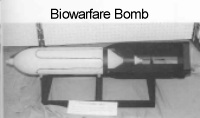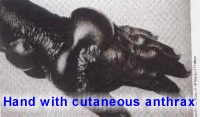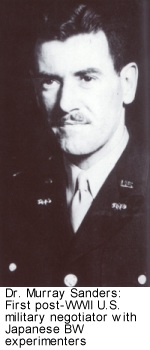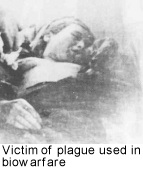|
Links:
 Demon
Doctors:Physicians as Serial Killers
Demon
Doctors:Physicians as Serial Killers
 Ethics in Emergency Medicine, 2nd
ed.
Ethics in Emergency Medicine, 2nd
ed.
The
History of Biological Warfare
From:
"Chapter 8: Viruses and Vivisections: Japan's Inhuman Experiments"
in Demon Doctors: Physicians as Serial Killers
By Kenneth V. Iserson, M.D.
Galen Press, Ltd., Tucson, AZ,
Biological
weapons are either living organisms that can reproduce, such as
bacteria or viruses, or toxic materials produced by living organisms,
such as toxins or physiologically active proteins or peptides. (Few
biological weapons produce skin lesions; mycotoxin, such as was
used in Kampuchea around 1980, is the rare exception.) Since they
must be either inhaled or ingested, biological warfare (BW) agents
must be dispersed as 1 to 10 µm particles or placed in food
or water sources.
While many potential
BW agents exist among the thousands of naturally occurring bacteria
and viruses, those of use in BW are limited by their:
1.
Ease of production
2. Stability
3. Infectivity or toxicity.
The
bacteria causing anthrax, Bacillus anthracis, is often considered
the best biological agent because of its stability for decades in
spore form and ease of production. Among viruses, Venezuelan equine
encephalitis is one of the most lethal, and among toxins, staphylococcal
enterotoxin and botulinum toxin are potential weapons.
Unlike chemical
weapons (CW), which have immediate devastating effects, BW agents
often cause early symptoms similar to common illnesses, take time
to develop their full potential, and, if caused by active agents,
can lead to widespread epidemics before the problem, agent, or source
is recognized. The terror produced by even the threat of such weapons
magnifies their effect on both military and civilian populations.
 Military
Use of BW Military
Use of BW
Armies have used biological warfare for millennia. As early as the
sixth century B.C., Assyrians poisoned enemy wells with rye ergot,
and Solon of Athens used the purgative herb, hellebore (skunk cabbage),
to poison the water supply during his siege of Krissa. In 400 B.C.,
Scythian archers dipped their arrows in blood and manure, attempting
to cause illness in their enemies. The Greeks polluted their enemy's
wells and drinking water supplies with animal corpses in 300 B.C.;
later the Romans and Persians would adopt the same strategy.
At the battle of
Tortona, Italy, in 1155, Barbarossa put human corpses in his enemy's
water supply, successfully contaminating it. Catapulting infected
corpses into besieged cities was commonplace during the medieval
period. In 1346-47, for example, the Muslim Tatar, De Mussis, catapulted
bubonic plague-infected corpses over the walls of Caffa on Russia's
Black Sea in Crimea, causing an epidemic. The city surrendered and
the defending Christian Genoese sailors fled to Italy, possibly
beginning the Black Death pandemic throughout Europe.
In 1422, during the siege of Karlstejn in the Holy Roman Empire,
soldiers' corpses and 2,000 cart loads of excrement were hurled
at the enemy. And, in 1485 near Naples, the Spanish supplied their
French enemies with wine laced with leprosy patients' blood.
In the eighteenth
century, unsophisticated but effective BW continued to be used.
In 1710, Russians catapulted plague-infected corpses into Reval,
Estonia, held by their Swedish enemies. In 1763, during the French
and Indian War, British Colonel Henry Bouquet gave smallpox-infected
blankets to the Indians at Fort Pitt, in western Pennsylvania, resulting
in a devastating epidemic. Using the same technique, Tunisians besieging
Christian-held La Calle in 1785 threw plague-infested clothing into
the city. While besieging Mantua, Italy in 1797, Napoleon attempted
to infect the inhabitants with swamp fever.
During the American
Civil War, Dr. Luke Blackburn, who would later become Kentucky's
governor, tried to infect Union troops by providing them with clothing
exposed to smallpox and yellow fever. (At that time, no one knew
that yellow fever can only be transmitted through mosquito bites.)
It is uncertain if this plan was successful, even though friends
and relatives of some Union officers claimed they died because of
Dr. Blackburn's efforts. Confederates under General Johnson, retreating
in Mississippi in 1863, tried to contaminate potential water sources
by leaving dead sheep and pigs in wells and ponds they passed. That
same year, however, U.S. Army General Order No. 100 stated: "The
use of poison in any manner, be it to poison wells, or food, or
arms, is wholly excluded from modern warfare."
During World War
I, bacteriological warfare became more sophisticated as microbiology
developed, the causative organisms for many diseases were identified,
and many were grown in laboratories. During the war, most biological
attacks were directed at animals using anthrax and glanders. The
Germans launched BW attacks in Romania, Italy, France, Russia, and
Mesopotamia. In the United States, the center for BW activity was
in Maryland, where Johns Hopkins-trained surgeon Dr. Anton Dilger
and his brother Carl produced bacteria to inject into military horses,
mules, and cattle destined for the Allied Expeditionary Force in
Europe. Although never used, the United States tested a devastating
biological toxin derived from castor beans, ricin, for military
use. A 1918 report reads:
These
experiments show two important points: (1) easily prepared preparations
of ricin can be made to adhere to shrapnel bullets, (2) there
is no loss in toxicity of firing and even with the crudest method
of coating the bullets, not a very considerable loss of the material
itself . . . It is not unreasonable to suppose that every wound
inflicted by a shrapnel bullet coated with ricin would produce
a serious casualty . . . Many wounds which would otherwise be
trivial would be fatal.
 Scrutinizing
BW Programs Scrutinizing
BW Programs
Despite this research in the mid-1920s, both the United States and
the new League of Nations claimed that BW was impracticable, either
because of inadequate delivery systems or because of enhanced public
health and preventive medicine systems. BW was banned in the 1925
Geneva Protocol signed by 28 nations (the U.S. Senate refused to
ratify it), about the time that Dr. Ishii Shiro was making his two-year
tour of foreign microbiology research facilities.
In 1931, as Japanese
Prince Mikasa revealed only in July 1994, his country's military
laced fruit with cholera germs in an unsuccessful attempt to poison
members of the League of Nations' Lytton Commission assigned to
investigate Japan's seizure of Manchuria. As Japan began its human
research experiments in BW and the Germans began the military training
and testing of offensive BW in the 1930s, the U.S. military was
disparaging the idea that it should be researched or that it could
be used. In an influential 1933 article in The Military Surgeon,
Major Leon F. Fox wrote, "Bacterial warfare is one of the recent
scare-heads that we are being served by the pseudo-scientists who
contribute to the flaming pages of the Sunday annexes syndicated
over the Nation's press."
 The
U.S. military appeared to be nearly alone in this attitude. In 1929,
the Soviet Union had opened a BW research facility north of the
Caspian Sea, and, by 1936, France had a large BW research program
and Britain had established a group to investigate offensive and
defensive BW issues. By 1939, Sir Frederick Banting, the discoverer
of insulin, had initiated Canada's BW research program with anthrax,
botulinum toxin, plague, and psittacosis. Britain opened their BW
laboratory in 1940. The
U.S. military appeared to be nearly alone in this attitude. In 1929,
the Soviet Union had opened a BW research facility north of the
Caspian Sea, and, by 1936, France had a large BW research program
and Britain had established a group to investigate offensive and
defensive BW issues. By 1939, Sir Frederick Banting, the discoverer
of insulin, had initiated Canada's BW research program with anthrax,
botulinum toxin, plague, and psittacosis. Britain opened their BW
laboratory in 1940.
Only in 1941, when
credible evidence arrived that the Japanese were using BW against
Chinese troops, did the U.S. government appoint a committee to study
BW, although no preparations were in place at the time of Pearl
Harbor.
By February 1942,
the United States had established the War Research Service to coordinate
defensive efforts against BW contamination of the nation's food
and water supply. As the war progressed, the government established
both offensive BW research programs and supplied selected troops
with defensive BW equipment. In June 1944, the U.S. government placed
an order for 1 million four-pound SPD Mk I BW cluster bombs, but
canceled it as the war ended.
During World War
II, Germany had a relatively small BW program, working mainly with
plague, cholera, typhus, and yellow fever. Japan had an extensive
program, as described in this chapter. BW, however, proved lethal
for even those working on or distributing the material. For example,
during the 1940s, about 1,600 Japanese researchers and soldiers
died from mishandling Unit 731's pathogens.
Common
Bw Agents: Used, Stockpiled, And Weaponized
| Disease:
Agent |
Signs
and Symptoms |
Theoretical
Toxicity* |
Time
to onset |
| Anthrax:Bacillus
anthracis |
Malaise,
fatigue, myalgia, fever, non-productive cough (early); followed
by severe respiratory distress, chest pain, sweating, swelling,
and shock. |
One
gram of spores could kill more than one-third of U.S. population.
50% exposed contract meningitis. Has a mortality rate of 100%
(despite appropriate treatment). |
1
to 6 days (inhaled) |
| Botulism:Botulinum
Toxin, Type-A; Clostridium botulinum |
Blurred
vision, lid droop, difficulty swallowing and speaking, muscle
weakness, respiratory distress, and death. |
Few
tenths of a microgram is lethal. Eight ounces could kill every
living creature on the planet. |
2
to 4 days (variable) |
| Brucellosis:Brucella
suis, melitensis, abortus, canis (human pathogenic types) |
Localized
inflammatory process, or acute febrile illness or chronic infection.
Depression, headache, and irritability frequently occur. |
Relatively
large amounts. |
3
days to several weeks |
| Plague:Yersinia
pestis |
Fever,
headache, vomiting, chills plus: Pneumonia with blood-tinged
sputum (pneumonic) or painful large skin blisters, altered mentation,
abdominal pain (bubonic) or purpura, disseminated intravascular
coagulation, abdominal pain, cyanosis/ necrosis of fingers and
toes (septicemic). |
Disease
caused by 1 to 10 organisms through the skin, or 100 to 20,000
inhaled. Up to 12% of those infected die from disease. |
24
hours (inhaled); 1 to 8 days (skin); 2 to 6 days (septicemic) |
| Q
Fever:Coxiella burnetii |
No
common pattern. |
One
organism. |
10
to 40 days |
| Smallpox:Orthopoxviridae
varioloa |
Malaise,
fever, rigors, vomiting, headache, backache, typical skin erruption. |
? |
12
days (average) |
| Tularemia:Francisella
tularensis |
Fever,
chills, headache, cough, myalgias, and pneumonia. Plus single
ulcer and lymphadenopathy (ulceroglandular) or systemic symptoms,
more common and severe pneumonia, without local skin lesion
or marked lymphadenopathy (typhoidal). |
10
to 50 inhaled organisms cause disease. Without treatment, has
a mortality rate of 4% (ulceroglandular) to 35% (typhoidal). |
3
to 6 days |
| Typhoid:Salmonella
typhosa |
Chills,
fever, cough, nosebleed, weakness, abdominal swelling and tenderness,
delirium, and rash. |
One
lb. of culture in drinking water is as toxic as 11 lbs. of botulinum
toxin or ten tons of potassium cyanide. |
10
to 12 days |
*If
optimally distributed. Higher doses are generally used in BW weapons,
since optimal dispersion generally cannot be achieved.
BW
Testing and Dissemination
In the 1950s, the United States continued its BW program, developing
multiple delivery methods for BW agents. The most successful of
these was the M114 four-pound antipersonnel bomblet, designed
to be part of a cluster bomb. It contained 320 milliliters of
Brucella suis (the bacteria causing brucellosis). The U.S. military
also concentrated on testing anthrax and yellow fever-producing
up to 500,000 mosquitos a month to carry the latter agent.
In several large-scale
open-air tests near heavily populated areas of the United States,
the military used Bacillus globigii, Serratia marcescens, and
inert particles to demonstrate that BW agents could be distributed
using natural continental air flows, making them potent weapons
of mass destruction. They also tested BW agents on human "volunteers,"
including civilian prisoners. During this period, the Soviet Union
was also conducting BW tests and was producing and storing large
amounts of BW agents.
By the 1960s,
the U.S. military was testing a number of vaccines against BW
agents on human "volunteers." (In late 2000, the VA
hospital system began testing former military personnel who may
have been unknowingly exposed to BW tests.) These vaccines included
immunizations against Venezuelan equine encephalomyelitis, tularemia,
anthrax, botulinum toxin, Rift Valley Fever, Q fever, Eastern
equine encephalomyelitis, and Western equine encephalomyelitis.
They had also
developed the SD-2 Drone, a 300-knot, remote-controlled, recoverable
aircraft, with a 100 nautical mile range, that could hold more
than 200 pounds of biological agent. They then developed the SD-5,
which sped along at Mach 0.75, had a 650 nautical mile range,
and sprayed its 1,260 pounds of BW agent through a tail nozzle.
The U.S. Military also developed and mass-produced several BW
bombs. In additional large-scale tests on unsuspecting civilians,
they disseminated Bacillus globigii, supposedly a noninfectious
agent with properties similar to anthrax, at various public sites,
including Washington, DC's National Airport and Greyhound Bus
Terminal and New York City's subway system.
Banning
BW
Only in November 1969, four months after the United Nations issued
a report condemning the production and stockpiling of chemical
and biological weapons, did President Richard Nixon renounce America's
use of BW, saying:
I
have decided that the United States of America will renounce the
use of any form of deadly biological weapons that either kill
or incapacitate. Our bacteriological programs in the future will
be confined to research in biological defense, on techniques of
immunization and on measures of controlling and preventing the
spread of disease.
At
the time, the United States had put into delivery systems ("weaponized")
the lethal BW agents for anthrax, tularemia, and botulinum toxin.
They also had stockpiles of at least four incapacitating BW agents,
as well as anti-crop agents. In February 1970, Nixon also banned
BW toxins.
 In
the mid-1970s, reports began to surface that BW agents-mostly
toxins-were being used in Southeast Asia and Afghanistan, primarily
by the Russian and the Vietnamese armies. The Soviet Union had
signed the Biological Weapons Convention in 1975 and specifically
stated that "the Soviet Union does not possess any bacteriological
agents and toxins, weapons, equipment or means of delivery." In
the mid-1970s, reports began to surface that BW agents-mostly
toxins-were being used in Southeast Asia and Afghanistan, primarily
by the Russian and the Vietnamese armies. The Soviet Union had
signed the Biological Weapons Convention in 1975 and specifically
stated that "the Soviet Union does not possess any bacteriological
agents and toxins, weapons, equipment or means of delivery."
Yet, on April
3, 1979, an accidental airborne leak of anthrax spores occurred
at a previously undetected biological weapons plant, the Soviet
Institute of Microbiology and Virology in Sverdlovsk, Russia.
Although only one BW weapon discharged and Soviet troops quickly
attempted to decontaminate the facility and the city, 66 people
downwind of the plant died of anthrax.
Only in 1992 did
Russian President Boris Yeltsin admit that Russia had an offensive
BW research program. Subsequently, it has been discovered that
they also were attempting to use recombinant DNA technology to
produce lethal venoms in common bacteria.
Estimates of Casualties Produced by Hypothetical
Biological Attack *
|
Agent
|
Downwind
Reach
(Miles)
|
Dead
|
Incapacitated
|
|
Rift
Valley Fever
|
0.6
|
400
|
35,000
|
|
Tick-borne
Encephalitis
|
0.6
|
9,500
|
35,000
|
|
Typhus
|
>3
|
19,000
|
85,000
|
|
Brucellosis
|
>6
|
500
|
125,000
|
|
Q
fever
|
>12
|
150
|
125,000
|
|
Tularemia
|
>12
|
30,000
|
125,000
|
|
Anthrax
|
>12
|
95,000
|
125,000
|
*
Release of 110 lbs. of agent from an aircraft along a 1¼
mile line upwind of a population center of 500,000.
Adapted from: Health Aspects of Chemical and Biological Weapons,
WHO, 1970.
Increasing BW Risk
Over the past two decades, the risk of BW has actually increased.
In the 1980s, authorities discovered terrorist groups in the United
States and Europe manufacturing typhoid bacillus, ricin, botulinum
toxin, and other BW agents that they planned to use on civilian
populations. The reasons are obvious: ease of production and low
costs. For example, NATO estimated that, in 2001, to produce 50
percent casualties in a square kilometer, it would cost about
$9,000 for conventional weapons, $4,000 for nuclear weapons, $3,000
for chemical agents and less than $5 for BW agents.
They also
have the benefit of not being detectable by ordinary means, such
as x-rays, dogs, and other devices, making them easy to transport.
Their delayed onset of action, from a few hours to a few weeks;
the ability of perpetrators to protect themselves against the
agent with a vaccine; difficulties recognizing a BW attack; and
no "signature" left at the scene makes it unlikely that
the perpetrators would be caught. And, much like a neutron bomb,
BW only affects living things, leaving structures intact.
The 1990s' Persian
Gulf War produced evidence that Iraq had a large BW facility at
al-Hakam. In 1995, Iraq admitted that this facility had prepared
about 19,000 liters of botulinum toxin, 8,400 liters of anthrax,
and 2,000 liters of aflatoxin and clostridium since 1988. They
had "weaponized" some of this material, loading it onto
more than 200 BW missiles, plus additional artillery shells, rockets,
aircraft spray tanks, and bombs. Iraq is not alone in its offensive
BW capability. Experts now believe that Iraq, North Korea, and
Russia may have stockpiled the smallpox virus for BW use. Smallpox
was eradicated from natural occurrence due to Herculean worldwide
public health efforts, so there is little immunity in any population.
Only in 1998 did
the world realize that Japan's Aum Shinrikyo cult, before its
1995 lethal nerve gas attack on a Tokyo subway, carried out at
least nine BW attacks. Over a five-year period, they had tried
to use BW agents against the Japanese legislature, the Imperial
Place, several sites in Tokyo, and U.S. Navy facilities. No deaths
resulted, because either their agents were not of sufficient virulence
or their delivery systems were faulty.
Civil defense
agencies now take the threat of BW agents seriously and work to
counteract terrorist groups that adopt Dr. Ishii's philosophy:
to employ the "silent enemy" of microbiology as a "silent
ally."
In 2001, shortly
after the World Trade Center tragedy, terrorists used the U.S.
postal system to distribute deadly anthrax spores, exposing thousands
to the biological weapon, and killing four victims. As of mid-November,
the identity of the perpetrators-whether foreign, domestic, or
both-is unknown.
©Galen
Press, Ltd., 2001
|
 EXTRAS
EXTRAS


 Military
Use of BW
Military
Use of BW Scrutinizing
BW Programs
Scrutinizing
BW Programs The
U.S. military appeared to be nearly alone in this attitude. In 1929,
the Soviet Union had opened a BW research facility north of the
Caspian Sea, and, by 1936, France had a large BW research program
and Britain had established a group to investigate offensive and
defensive BW issues. By 1939, Sir Frederick Banting, the discoverer
of insulin, had initiated Canada's BW research program with anthrax,
botulinum toxin, plague, and psittacosis. Britain opened their BW
laboratory in 1940.
The
U.S. military appeared to be nearly alone in this attitude. In 1929,
the Soviet Union had opened a BW research facility north of the
Caspian Sea, and, by 1936, France had a large BW research program
and Britain had established a group to investigate offensive and
defensive BW issues. By 1939, Sir Frederick Banting, the discoverer
of insulin, had initiated Canada's BW research program with anthrax,
botulinum toxin, plague, and psittacosis. Britain opened their BW
laboratory in 1940.  In
the mid-1970s, reports began to surface that BW agents-mostly
toxins-were being used in Southeast Asia and Afghanistan, primarily
by the Russian and the Vietnamese armies. The Soviet Union had
signed the Biological Weapons Convention in 1975 and specifically
stated that "the Soviet Union does not possess any bacteriological
agents and toxins, weapons, equipment or means of delivery."
In
the mid-1970s, reports began to surface that BW agents-mostly
toxins-were being used in Southeast Asia and Afghanistan, primarily
by the Russian and the Vietnamese armies. The Soviet Union had
signed the Biological Weapons Convention in 1975 and specifically
stated that "the Soviet Union does not possess any bacteriological
agents and toxins, weapons, equipment or means of delivery."